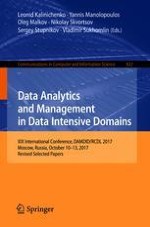2018 | Buch
Data Analytics and Management in Data Intensive Domains
XIX International Conference, DAMDID/RCDL 2017, Moscow, Russia, October 10–13, 2017, Revised Selected Papers
herausgegeben von: Leonid Kalinichenko, Prof. Yannis Manolopoulos, Oleg Malkov, Nikolay Skvortsov, Sergey Stupnikov, Vladimir Sukhomlin
Verlag: Springer International Publishing
Buchreihe : Communications in Computer and Information Science
